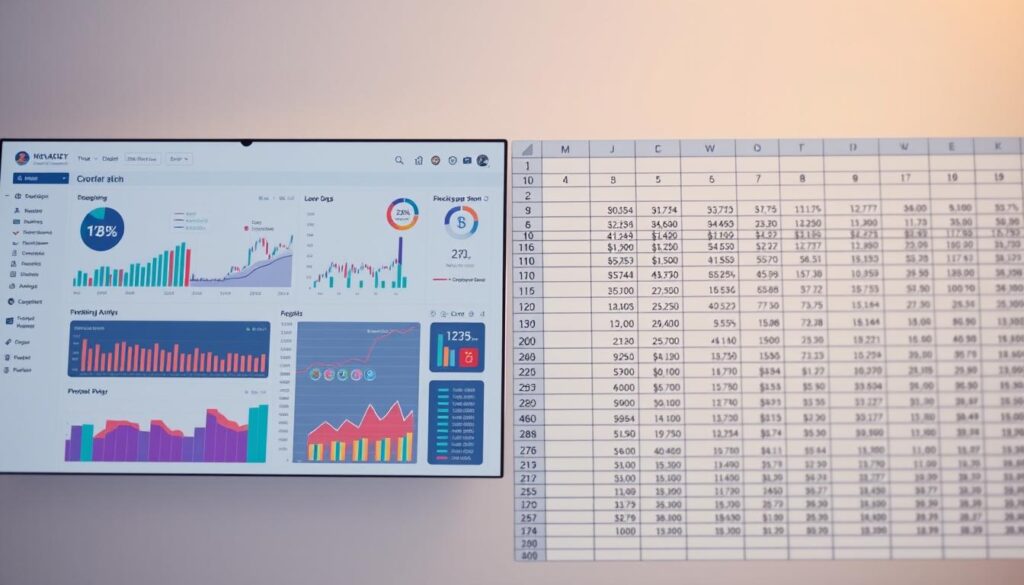Now Reading: Machine Learning Crypto Liquidity Analysis: Insights & Trends
- 01
Machine Learning Crypto Liquidity Analysis: Insights & Trends
Machine Learning Crypto Liquidity Analysis: Insights & Trends

The digital asset landscape is one of the most dynamic sectors in modern finance. Prices can swing dramatically in short timeframes. This creates both major opportunities and significant challenges for traders and investors.
Traditional financial assessment methods often struggle in this environment. The market operates 24/7 and has unique characteristics. These factors make conventional analysis less effective.
Advanced computational techniques have emerged as powerful solutions. They enable sophisticated pattern recognition and predictive modeling. This guide explores how these technologies transform liquidity assessment.
We will cover everything from fundamental concepts to cutting-edge algorithmic systems. The goal is to provide you with actionable insights into market dynamics. Understanding these trends is crucial for navigating the volatile world of digital assets.
Key Takeaways
- The cryptocurrency market is highly volatile, presenting unique challenges for analysis.
- Traditional financial methods are often inadequate for assessing digital asset liquidity.
- Advanced computational techniques offer more sophisticated pattern recognition.
- These technologies enable better predictive modeling and risk assessment.
- This guide provides a comprehensive look at modern trading system methodologies.
- Understanding these insights is key to navigating current market trends effectively.
Introduction to Cryptocurrency Liquidity and Machine Learning
The fusion of computational intelligence with financial assessment is revolutionizing how we understand digital asset markets. Traditional approaches often fall short when dealing with the unique characteristics of these markets.
Cryptocurrency liquidity measures how easily digital assets can be traded without major price impacts. This factor is critical for participants across the entire ecosystem.

Advanced computational techniques process enormous amounts of market information. They identify patterns that conventional methods might miss entirely.
These technologies provide a significant competitive edge in today’s trading environment. Understanding their application offers substantial value for market participants navigating complex digital economies.
The Landscape of Cryptocurrency Markets
The world of digital asset trading presents a fundamentally different ecosystem from traditional financial markets. This unique environment operates without the constraints that govern conventional exchanges.

Market Volatility and Trading Dynamics
Digital currency markets experience dramatic price swings regularly. Individual assets can fluctuate 10-50% within single sessions.
This volatility creates both profit opportunities and significant risks. Market participants must navigate rapid price movements carefully.
Various factors influence these dynamics. Blockchain developments and regulatory news can trigger immediate reactions across connected markets.
Global Accessibility and 24/7 Trading
The cryptocurrency market operates continuously without closures. This 24/7 nature enables constant price discovery across time zones.
Global accessibility allows traders worldwide to participate simultaneously. Internet connectivity provides entry to multiple exchanges and trading pairs.
This continuous operation distinguishes digital asset markets from traditional systems. Understanding these characteristics is essential for effective participation.
Traditional Analysis vs. Machine Learning Approaches
Evaluating market conditions in the digital asset space requires tools that can handle its inherent complexity. Older financial assessment techniques often struggle to keep pace.
Models like GARCH work well in conventional markets. However, they frequently fall short when facing the extreme volatility of digital assets.

Classical technical indicators offer limited insight. Their linear assumptions cannot process the multiple data streams present in modern trading environments.
In contrast, modern computational systems demonstrate superior pattern recognition. They effectively capture non-linear relationships that evade normal statistical techniques.
These advanced systems excel at handling high-dimensional datasets. They can incorporate diverse information sources into a single, unified framework.
| Aspect | Traditional Methods | Modern Computational Approaches |
|---|---|---|
| Data Handling | Struggles with high-dimensional, real-time data | Excels at processing multiple, diverse data streams simultaneously |
| Pattern Recognition | Limited to linear relationships and simple dynamics | Captures complex, non-linear patterns and market interactions |
| Adaptability | Slow to adapt to rapidly changing market conditions | Designed to learn and evolve with new information |
| Prediction Accuracy | Often inadequate for volatile price movements | Empirically validated for superior forecasting performance |
The shift towards these intelligent models is driven by market needs. Improved prediction accuracy provides a tangible advantage for participants.
Studies consistently show that ensemble methods and deep architectures outperform older forecasting models. This paradigm shift is reshaping how we understand market dynamics.
Understanding “machine learning crypto liquidity analysis”
Modern algorithmic approaches bring unprecedented precision to assessing trading conditions across digital markets. These sophisticated systems process vast amounts of information to identify patterns that human analysts might overlook.

Key Concepts and Definitions
Advanced computational techniques simulate human cognitive processes to evaluate complex relationships. They create interpretation mechanisms that identify connections between various market factors.
Digital asset fluidity is measured through multiple dimensions. These include trading volume, market depth, and bid-ask spreads.
| Measurement Dimension | Definition | Importance |
|---|---|---|
| Trading Volume | Total value of assets exchanged within a specific period | Indicates market activity and participant interest |
| Market Depth | Quantity of buy and sell orders at different price levels | Shows market resilience to large trades |
| Bid-Ask Spread | Difference between highest buy and lowest sell prices | Reflects transaction costs and market efficiency |
Comparative Benefits Over Traditional Methods
These intelligent systems process massive datasets in real-time. They automatically adapt as market conditions evolve.
The superior pattern recognition capabilities capture non-linear relationships between variables. They integrate diverse data types from numerical price information to textual sentiment indicators.
This approach provides quantitative assessments that older methods cannot deliver. Market participants gain actionable insights for position sizing and risk management.
Machine Learning Models in Cryptocurrency Trading
Sophisticated computational systems are reshaping how traders approach digital asset markets through advanced predictive techniques. These intelligent frameworks process enormous datasets to identify patterns that drive successful trading decisions.
Different algorithmic architectures serve distinct purposes in market forecasting. Understanding their strengths helps traders select the right tools for specific scenarios.
Ensemble Methods: Gradient Boosting & XGBoost
Ensemble techniques combine multiple weaker predictive systems to create robust forecasting models. Gradient Boosting algorithms sequentially build decision trees that correct previous errors.
XGBoost represents a particularly effective implementation of this approach. It handles large volumes of market information while preventing overfitting through regularization.
These methods demonstrate superior performance in volatile trading environments. Their ability to capture complex non-linear relationships makes them valuable for price movement forecasting.
Recurrent Neural Networks and LSTM Applications
Recurrent architectures excel at processing sequential data by maintaining memory of previous states. This capability is crucial for understanding temporal patterns in asset values.
LSTM networks specifically address limitations of standard recurrent models. They effectively learn long-term dependencies across hours, days, or weeks of trading activity.
Empirical studies show these networks achieve impressive prediction accuracy compared to traditional methods. Their strength lies in discerning temporal trends within volatile market conditions.
Data-Driven Strategies for Liquidity Prediction
Successful forecasting in digital asset markets depends heavily on transforming raw information into actionable intelligence. This transformation process forms the core of modern prediction systems.
Feature engineering combines traditional technical indicators with blockchain-specific metrics. Moving averages and RSI merge with on-chain transaction volumes and network activity.
Feature Extraction and Data Preprocessing
Data preparation involves cleaning noisy market information and handling missing values. Normalization ensures different scales don’t distort model performance.
Time-series techniques create lagged features capturing historical patterns. Rolling window statistics summarize recent trading behavior effectively.
| Data Type | Extraction Challenge | Predictive Value |
|---|---|---|
| Price-Volume Data | Handling 24/7 trading without session boundaries | High for short-term movement forecasting |
| On-Chain Metrics | Identifying entity addresses to detect manipulation | Critical for network health assessment |
| Sentiment Indicators | Synchronizing diverse update frequencies | Valuable for market sentiment correlation |
Blockchain data extraction faces complex identification challenges. Revealing artificial factors requires sophisticated address analysis techniques.
Effective models incorporate multi-dimensional feature sets. These span from order book depth to macroeconomic variables for comprehensive assessment.
Advanced Algorithms for Price Prediction and Trend Analysis
Hybrid algorithmic systems represent the next evolution in digital asset forecasting. These approaches combine multiple computational architectures to achieve superior results. They address the limitations of single-model frameworks.
Research demonstrates that hybrid frameworks consistently outperform individual methods. Kumar and Ravi’s LSTM-XGBoost model exemplifies this advancement.
Hybrid Models and Their Performance Metrics
The LSTM-XGBoost architecture captures temporal patterns through LSTM networks. Simultaneously, XGBoost handles complex non-linear relationships. This combination delivers enhanced prediction accuracy across multiple digital currencies.
Raza et al. developed a CNN-LSTM hybrid with variational autoencoders. This system achieved remarkable performance benchmarks for Bitcoin valuation. The model recorded an MSE of 0.0002 and R² score of 0.99.
These hybrid frameworks show 15-30% improvement over single-algorithm approaches. Their success stems from combining complementary strengths. No single model captures all market dynamics effectively.
Performance evaluation uses metrics like MAE, MSE, and R-squared values. These measurements quantify forecasting precision under different market conditions. Superior metrics translate to better trading decisions.
Liquidity Ranking Metrics in Crypto Trading
Sophisticated liquidity ranking systems provide traders with essential tools for navigating digital asset markets effectively. These frameworks combine multiple measurement approaches to deliver comprehensive assessments.
Proper evaluation requires understanding three core components that work together. Each metric offers unique insights into market conditions.
Volume, Market Depth, and Spreads Explained
Trading volume shows the total value exchanged during specific periods. This indicates market activity levels and participant interest.
Market depth provides exact dollar figures available within price ranges. It measures how much capital would move values by specific percentages.
The bid-ask spread reflects transaction costs between buy and sell orders. Narrow spreads signal healthy conditions with minimal slippage.
| Metric | Primary Function | Practical Significance |
|---|---|---|
| Trading Volume | Measures market activity over time | Indicates participant interest and market vitality |
| Market Depth | Quantifies orders at different price levels | Shows resilience to large trades and capital requirements |
| Bid-Ask Spread | Calculates difference between buy/sell prices | Reflects transaction costs and execution efficiency |
Market capitalization alone often misleads investors about true liquidity conditions. Tokens with large valuations may have poor trading conditions.
Comprehensive ranking approaches weight these measures equally. This provides realistic assessments of transaction costs and position entry/exit ease.
Leveraging Big Data in Crypto Market Analysis
Advanced data processing capabilities have opened new frontiers in understanding complex trading ecosystems. Modern frameworks now handle unprecedented information volumes that traditional methods cannot process effectively.
The digital asset space generates massive datasets daily. These include transaction records, price updates, and order book snapshots across hundreds of platforms.
| Technology | Primary Function | Market Application |
|---|---|---|
| GPU Processing | Parallel computation for complex models | Reduces training time from weeks to hours |
| Distributed Systems | Handles streaming data from multiple sources | Enables real-time decision making |
| Deep Learning Frameworks | Simplifies model implementation and testing | Lowers technical barriers for market participants |
Graphics processing units provide the computational power needed for complex predictive systems. They transform what was once impractical into actionable intelligence.
Modern programming packages like TensorFlow and PyTorch have democratized access to sophisticated analytical tools. These frameworks support the development of robust forecasting methodologies.
The continuous evolution of data infrastructure creates significant advantages for informed participants. Those leveraging these technologies gain superior insights into market dynamics.
Big data applications extend beyond simple price prediction to comprehensive market assessment. They identify patterns, anomalies, and opportunities that traditional approaches miss entirely.
Integrating Sentiment Analysis and On-Chain Data
Understanding the collective mood of market participants has become a cornerstone of modern digital asset evaluation. This approach combines psychological signals with fundamental blockchain metrics.
Social platforms like Twitter and Reddit offer a real-time pulse of trader sentiment. Natural language processing systems scan millions of posts to gauge bullish or bearish trends.
Social Media Impact on Price Movements
Research shows that sentiment often shifts before major value changes. Alnami’s study found that adding Twitter-based mood indicators to technical tools improved forecast accuracy.
Li et al. developed a sophisticated framework that separates factual news from subjective opinions. This decoupling leads to more profitable trading signals.
On-chain data provides a different perspective. It includes metrics like active addresses and transaction volumes.
These figures reflect the actual health and usage of a digital network. Combining this with market sentiment analysis creates a powerful, multi-layered view.
| Data Type | Primary Insight | Trading Application |
|---|---|---|
| Sentiment Indicators | Measures collective trader psychology and emotion | Predicts short-term price swings driven by news and hype |
| On-Chain Metrics | Reveals fundamental network usage and health | Assesses longer-term value and adoption potential |
| Combined Framework | Captures both psychological and fundamental factors | Provides a comprehensive model for entry and exit timing |
This integrated method helps traders navigate both emotional spikes and underlying value. It is a significant advancement in digital asset assessment.
Algorithmic Trading and Automated Decision-Making Systems
Automated execution frameworks are transforming how capital flows through digital asset exchanges by removing human limitations from the trading equation. These sophisticated systems operate continuously across global markets without requiring manual intervention.
Institutional investors now allocate substantial resources to quantitative trading strategies. Hedge funds recognize that automated approaches process information faster than human traders can comprehend.
Modern automated frameworks integrate prediction models for signal generation with risk management modules. Execution algorithms optimize order placement to minimize transaction costs.
The stability of prediction models directly impacts portfolio management decisions. Institutions require transparent systems that satisfy regulatory standards while delivering consistent performance.
Quantitative strategies employ diverse approaches including trend following and statistical arbitrage. These models continuously adapt parameters based on evolving market conditions.
High-frequency trading systems execute thousands of transactions daily. They capitalize on minute price discrepancies that escape human perception.
Development requires extensive backtesting and careful monitoring during live trading. Documented cases show CNN-based systems achieving returns that outperform traditional benchmarks.
Regulatory Impact and Risk Management in Cryptocurrency
Government policies and international regulations now significantly influence the stability and growth potential of token-based economies. European Central Bank studies highlight unique threats to financial stability that traditional systems cannot address.
Recent market events demonstrate critical risk management failures. The Celsius and FTX collapses revealed catastrophic liquidity issues with illiquid assets.
Liquidity Risk Management Techniques
Effective portfolio management requires diversification across independently liquid markets. Stress testing positions under adverse scenarios helps identify potential vulnerabilities.
Institutional trading systems incorporate Value-at-Risk models and scenario analysis frameworks. These tools quantify potential losses under various market conditions.
| Technique | Primary Function | Implementation |
|---|---|---|
| Diversification | Spreads exposure across multiple assets | Reduces dependency on single market factors |
| Stress Testing | Simulates adverse market conditions | Identifies portfolio weaknesses before crises |
| Exposure Limits | Controls position sizes in illiquid assets | Prevents concentration in high-risk holdings |
Regulatory frameworks continue evolving globally. Adaptive management systems must respond to changing legal requirements across jurisdictions.
The integration of regulatory risk factors into predictive models helps anticipate market reactions. This approach positions portfolios defensively before policy announcements.
The Role of Reinforcement Learning in Adaptive Trading Strategies
Self-improving algorithmic frameworks are transforming how capital is allocated across volatile markets. These systems learn through trial-and-error interactions rather than relying on static rules.
Deep reinforcement learning combines neural networks with decision-making principles. This creates agents capable of processing complex market state representations.
Ensemble frameworks leverage parallel GPU simulations to train multiple agents simultaneously. Each agent explores different strategies while the system dynamically selects top-performing policies.
| Approach | Key Feature | Market Application |
|---|---|---|
| Single Agent RL | Learns one policy through environmental feedback | Basic strategy optimization for stable conditions |
| Deep RL (DRL) | Processes high-dimensional state representations | Complex pattern recognition in volatile environments |
| Ensemble RL | Dynamically selects best policy from multiple agents | Adaptive strategy switching based on current regime |
Real-world application faces challenges like policy instability and sampling bottlenecks. Financial data’s non-stationary nature requires continuous adaptation.
Research shows ensemble approaches achieve better risk-adjusted returns than single-agent systems. They optimize comprehensive objectives including transaction costs and market impact.
This evolution moves toward truly autonomous trading frameworks. Systems can discover novel strategies and improve performance over time without constant human intervention.
Insights from Academic and Industry Research
Systematic comparisons across different computational frameworks reveal important patterns in digital currency forecasting performance. These investigations provide clear guidance for developing effective trading systems.
Comparative Studies and Empirical Findings
Recent academic research has conducted thorough comparisons of various predictive model types. Studies examine ensemble trees, support vector regression, and recurrent neural networks using identical data sets.
The findings consistently show ensemble methods outperforming individual deep learning approaches. This challenges assumptions that complex neural architectures always deliver superior results.
XGBoost and Gradient Boosting models achieve higher prediction accuracy than LSTM networks for many digital assets. This holds true particularly when datasets include engineered features.
One important example reveals that standardized testing procedures enable meaningful cross-study comparisons. Previous inconsistencies arose from different evaluation metrics and time periods.
Industry research complements academic work by addressing practical deployment challenges. These include real-time inference latency and performance degradation over time.
The convergence of academic and industry findings points toward hybrid approaches. These combine ensemble methods’ robustness with deep learning’s pattern recognition capabilities.
Future Outlook and Emerging Trends in Crypto Trading Technologies
As digital markets mature, the frontier of trading innovation shifts toward autonomous, self-improving frameworks. Community initiatives like the FinRL Contests demonstrate this evolution by creating standardized testing environments.
These platforms provide end-to-end task formulations and automated data pipelines. They enable rigorous comparison of different algorithmic approaches across identical conditions.
Transfer learning represents a significant advancement for handling new asset types. Models trained on established markets can adapt to emerging tokens with limited historical data.
Explainable AI technologies are becoming essential for institutional adoption. Techniques like SHAP provide transparency into how predictive models generate signals.
Quantum computational approaches offer theoretical advantages for complex optimization tasks. Meanwhile, DeFi integration creates new data flows requiring specialized modeling techniques.
Multi-agent frameworks simulate competitive market environments. They help discover robust strategies that perform well against diverse participants.
The ultimate evolution points toward continuous learning systems. These frameworks automatically update deployed models without human intervention.
Conclusion
Contemporary trading methodologies leverage sophisticated computational systems to decode the complex dynamics of modern financial ecosystems. This transformative approach equips market participants with powerful tools for navigating digital asset markets effectively.
The integration of diverse analytical frameworks enables comprehensive assessment that captures both straightforward relationships and intricate patterns in cryptocurrency dynamics. Effective evaluation requires multi-dimensional measures beyond basic metrics.
The future of digital asset trading lies in adaptive systems that continuously learn from market feedback. These frameworks integrate varied data sources and adjust strategies dynamically as conditions evolve.
While significant progress has been made, challenges remain in standardization and real-time adaptation. The insights presented throughout this guide provide valuable understanding of how advanced technologies transform market assessment.
As digital markets mature, the integration of computational intelligence will continue deepening. This creates opportunities for those who effectively leverage data-driven approaches while managing inherent risks.
FAQ
What is the main advantage of using automated systems for analyzing digital asset markets?
The primary benefit is the ability to process enormous datasets in real-time. These systems can identify subtle patterns and correlations in trading volume and order book depth that are often invisible to manual analysis, leading to more informed and timely decisions.
How do predictive models improve decision-making for traders?
These algorithms forecast potential price movements and assess market conditions by learning from historical data. This provides traders with data-driven insights into trend analysis and potential risks, enhancing their overall portfolio management strategy.
What types of information do these advanced systems use for their assessments?
They integrate various data sources, including real-time transaction data, order book activity, social media sentiment, and on-chain metrics. This multi-factor approach offers a comprehensive view of asset value and market dynamics.
Can these techniques help manage exposure in volatile conditions?
A> Yes, absolutely. By continuously monitoring spreads and market depth, these systems can provide early warnings of changing conditions. This allows for proactive risk management, helping to protect an asset’s value during periods of high fluctuation.
What role does anomaly detection play in this process?
Anomaly detection is crucial for identifying unusual activity that may signal market manipulation or a sudden shift in supply and demand. Flagging these outliers helps traders avoid unexpected losses and maintain better control over their positions.














